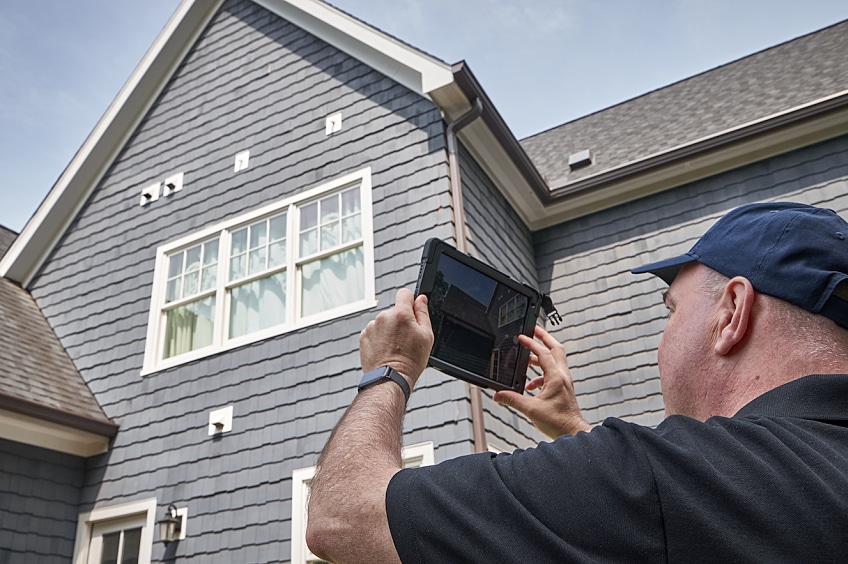Regular maintenance can significantly extend your roof's life. Assessing your roof each year can help you find minor issues early, enabling you to address them before they turn into serious problems or damage your roofing system.
While you may be able to identify and fix some problems yourself, hiring a professional contractor to inspect your roof can help you discover complications that aren't immediately obvious to the untrained eye. Here are roofing tips to help you keep your roof in the best shape—and know when to hire a professional.
Check for Damaged Shingles
One of the most important roofing tips is to check for damaged shingles before and after your area's harshest season. Damaged shingles can allow moisture to enter your home through any gaps, and loose shingles can fly away with sharp winds.
Inspect your roof safely from the ground, looking for curled, missing, or cracked shingles. Call a professional roofer to repair or replace any damaged shingles.
Clean Gutters
Routinely cleaning your gutters to remove leaves and other debris allows runoff water to properly drain away from your property. When drains are clogged, standing water can enter your roofing structure and damage the roofing deck, leading to rot.
It's not just the roof that can experience problems—water can overflow onto your home's siding and foundation. Prolonged water exposure on siding can cause the material to absorb the water and crack or peel. Excessive water around your home's foundation can cause the nearby soil to expand and contract, potentially leading to cracks in the foundation.
Another important roof tip is cleaning your gutters at least twice a year. Since you may need to get on a ladder to reach them, many roofers also offer gutter cleaning as a service.
Remove Moss and Algae
Moss and algae thrive in damp environments, so you can often find them living in the shaded areas of your roof where the sun doesn't dry out moisture. While moss and algae can give your roof a distinct look, leaving them untreated can cause problems like lifted shingles and mold growth.
To remove moss and algae from your roof, spray an equal mixture of water and bleach onto your roof from the ground. Bleach is an easy way to kill both plants, but be careful when applying it and wear proper safety gear. After, rinse the area with water to prevent leftover bleach from affecting nearby vegetation you don't want to kill.
Trim Tree Branches
As tree branches grow, they can scratch your roof, causing the shingles to lose granules. Granule loss makes shingles vulnerable to ultraviolet rays and other harsh weather conditions. Overgrown branches could also fall on your roof.
Cut any branches that directly overhang your roof to prevent damage. Fewer branches also mean fewer leaves that can pile up and clog gutters, making cleaning easier.
Repair Broken Flashing
Flashing is typically installed on roof valleys (vulnerable areas where two slopes meet) to prevent water from seeping inside the roofing structure.
Flashing can sometimes become rusted or warped due to temperature changes and excessive moisture and snow. Since inspecting the flashing typically requires you to get on the roof, it's often best to leave this inspection to a professional.
Look for Leaks
One of the best areas to look for roof leaks is from inside your attic. Signs of leaks include water stains or a musty odor, which may indicate mold and mildew growth. Hire a roofing professional to help determine the cause and address the issue.
Assess the Attic Ventilation System
A proper attic ventilation system prevents moisture buildup and regulates temperatures. Ventilation helps avoid ice dams (when snow melts and refreezes) in the winter and keeps the attic and roof from getting too hot in the summer.
If your attic is sweltering in the summer or freezing in the winter compared to other parts of your home, you may have ventilation problems. Check the vents to ensure they aren't clogged with insulation or other debris.
Inspect Rooftop Fixtures
Check rooftop fixtures like skylights, vents, antennas, and chimneys for damage. If you notice any broken parts, rusting, or peeling, you may want to replace them. Even small openings can allow water infiltration. Meanwhile, broken or sharp objects can scratch against your roofing shingles or blow off during sharp winds and damage the area.
Address Pest Infestations
Pest infestations can occur in all areas of a home, but it's common for pests to make their way inside through the roof. Squirrels can chew through your roof decking, causing structural damage, while insects and birds can use home insulation as nesting material.
Seasonal weather changes are a popular time for pest infiltration. Look for signs like squeaking or scratching noises coming from the attic and animal droppings.
Hire a Professional Roofing Contractor
While you can do some of these preventative roof maintenance tasks yourself, a roofing professional can help pinpoint issues that may not be obvious. An experienced contractor can assess your roof for problems and address them before they cause serious damage. Contact a GAF-certified contractor* to schedule a roof inspection.
*Contractors enrolled in GAF certification programs are not employees or agents of GAF, and GAF does not control or otherwise supervise these independent businesses. Contractors may receive benefits, such as loyalty rewards points and discounts on marketing tools from GAF for participating in the program and offering GAF enhanced warranties, which require the use of a minimum amount of GAF products. Your dealings with a Contractor, and any services they provide to you, are subject to the GAF Contractor Terms of Use.

